
How-to libguides containing general information literacy guidance.
- Subject:
- Education
- Material Type:
- Reference
- Student Guide
- Tutorial
- Provider:
- CUNY
- Provider Set:
- York College
- Author:
- York College Library
- Date Added:
- 02/22/2024

How-to libguides containing general information literacy guidance.

This color coded guide was inspired by the citation guides from the Valencia College, a community college in Florida, website.
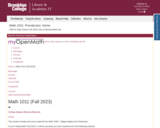
MATH *1011 Precalculus Mathematics
(Prior to Fall 2010, this course was known as MATH 2.9.
The information below might still reflect the old course numbers. Bracketed numbers, if any, are the old course numbers. Learn more...)
4 hours; 3 credits
Preparation for calculus. Trigonometry. The concept of function, including, linear and quadratic functions, composition of functions, polynomials and rational functions, exponential, logarithmic, trigonometric, and inverse trigonometric functions. Conic sections. Binomial theorem. Introduction to limit ideas. (Not open to students who are enrolled in or have completed Mathematics 1021, 1026, 1201, 1206, or any Mathematics course numbered over 2000.) STEM variant course - Satisfies Pathways Required Core Math and Quantitative Reasoning requirement.
Prerequisite: All students entering into Mathematics 1011 must have met one of the following conditions: Received a B- or higher in Mathematics 1006, achieved minimum scores on the COMPASS test of s1 = 70, s2 = 70, and s3 = 45; achieved a minimum score of 70 on the ACCUPLACER College-Level Math test; placement by departmental examination; or permission of the deputy chair.

MATH *1201 Calculus I
(Prior to Fall 2010, this course was known as MATH 3.3.
The information below might still reflect the old course numbers. Bracketed numbers, if any, are the old course numbers. Learn more...)
4 hours; 4 credits
Mathematics 1201, 1206 and 2201 constitute a three-term sequence. Mathematics 1201 is an introduction to calculus: limits and continuity; derivatives and integrals of algebraic, exponential, logarithmic, and trigonometric functions of one variable; methods of numerical approximation, and applications of the derivative to mathematics, physics, engineering, biology, chemistry, and other fields. STEM variant course - Satisfies Pathways Required Core Math and Quantitative Reasoning requirement.
Prerequisite: All students entering into Mathematics 1201 must have met one of the following conditions: earned a grade of C- or higher in Mathematics 1011, 1012 or 1026; achieved minimum scores on the COMPASS test of s1 = 70, s2 = 70, s3 = 70, and s5 = 70; achieved a minimum score of 105 on the ACCUPLACER College-Level Math test; or obtained departmental permission.

This course introduces students to the scientific study of mental processes and human behavior and provides a foundation in the principles, methods, and theories of psychology. Students will study psychology’s major areas of inquiry, including the history of psychological science, sensory and perceptual processes, learning and cognition, motivation and emotion, human development, social influences, as well as psychological disorders and treatment.

This tutorial shows you how to avoid the serious academic offense of plagiarism.

This podcast reviews the concepts of project Time, scope, cost, quality, risk, HR, Communication, Integration, and procurement management.

This resource consists of two .zip files that have reading guides for the College Physics textbook at openstax.org. Each zip file has Word documents for the standard first and second semester set of topics for a year-long freshman level college physics course. The reading guides summarize the key points, provide extra explanations, and pose questions for the student. The reading guides were written for the first edition of the textbook. Permission is granted for free use and editing of the reading guides.

A student guide with tips for clarifying topic and narrowing research question, understanding different resource types and how to find them, evaluating relevance, credibility, and readability of sources, and citation.

A Research Toolkit covering: 1.What is my research question? 2. How do I find sources? 3. How do I read this stuff? 4. How do I use sources in my paper? 5. Faculty Guide

CUNY Professors Millicent Freeman and Diane Banks led this two-hour workshop intended to raise awareness and discuss the complexities of an urban student's experience, and their narratives of resilience. This resource is the Power Point presentation used at the event. It includes a long list of resources for CUNY students' health and wellness. Millicent Freeman, (she/her) recently retired from the NYC DOHMH, Director of Outreach of Training at the New York City DOHMH Bureau of Sexually Transmitted Infections. She is an Adjunct Professor at the Borough of Manhattan Community College, in the Department of Ethnic and Race Studies. She holds a masters’ degree in Health Education and PhD in Counseling.
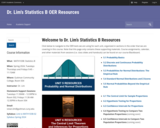
MATH 103B picks up from learning fundamental concepts in probability to continue study concepts and methods in inferential statistics, including normal probability distributions, sampling distributions, confidence intervals, and hypothesis testing of the proportion and the mean.
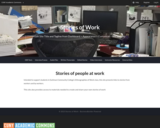
Stories of people at work
Intended to support students in Guttman Community College’s Ethnographies of Work class, this site presents links to stories from workers and by workers.

When you are writing a research paper, your professor will ask you to prepare it according to an accepted style. The two most often used are from the Modern Language Association (MLA) for the Humanities, and the American Psychological Association (APA) for the Social Sciences and other disciplines. This guide gives you a collection of sites from around the web that will help you get started using them. Covers MLA, APA, and citing from databases.

This Prof-Proof-Planner is designed by Professors Marta Cabral (College of Staten Island) and Niyati Mehta (Queensborough Community College) to help students navigate syllabi, regardless of how dis/organized, un/clear, or fluid/ strict/ they may be. The goal is for students to take the time to digest the essential information as they take note of it on this planner, jot down due dates, characteristics of each assignment (in terms of effort/ time required, group/individual, etc.), how to contact instructors, characteristics of each course, etc. Throughout the planner there are short reminders that each student is encouraged strive to make meaningful connections between each assignment/ course and their personal and professional interests, and there are places to write down these reflections and notes. We welcome feedback, as we would love to keep adapting this tool to our students’ needs!
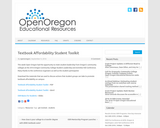
Materials that can be used to discuss actions that student groups can take to promote textbook affordability on campus. Includes PDF, Word, and slides.

Three Steps to Claim your Digital Workspace! is a quick reference guide intended to help students, teachers, and performers to feel empowered to create and claim a Digital Workspace: a vital resource in the coming years. The easy to follow steps can be an excellent guide for you as you work to make space for your creative self in the digital world. Co-created by Beto O’Byrne, Ashley Tata, and Michael Alifanz.

Picking a Topic or Research Question IS ACTUAL RESEARCH and part of the research process. When you first pick a research topic, it isn’t set in stone. It’s just a general idea of something that interest you, that you will test with some exploratory research. If you like the results you are finding and it seems to provide answers to the questions you are trying to answer in your paper, then it looks like you can continue to find additional sources and start your paper. HOWEVER, if you are finding very limited results or too big a range of results, then now is the time to tweak your topic choice or even change it completely. This LibGuide will assist you through the 'Topic' selection process.
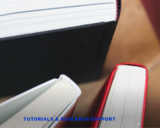
A website of video tutorials to assist student research. Some of the materials covered include developing research questions, search strategies, academic sources, locating a book, databases, evaluating, Ebooks, and citations.